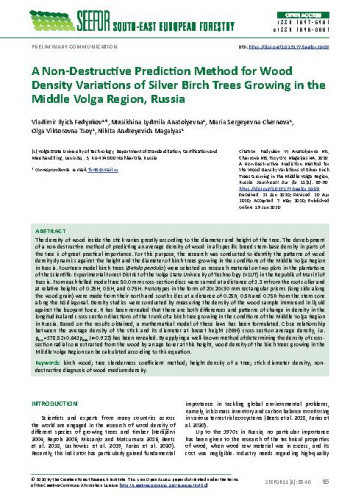The density of wood inside the stick varies greatly according to the diameter and height of the tree. The development of a non-destructive method of predicting an average density of wood in all specific breed stem-base density in parts of the tree is of great practical importance. For this purpose, the research was conducted to identify the patterns of wood density dynamics against the height and the diameter of birch trees growing in the conditions of the Middle Volga Region in Russia. Fourteen model birch trees (Betula pendula) were selected as research material on two plots in the plantations of the Scientific-Experimental Forest District of the Volga State University of Technology (VSUT) in the Republic of Mari El of Russia. From each felled model tree 50.0 mm cross-section discs were carved at a distance of 1.3 m from the root collar and at relative heights of 0.25H, 0.5H, and 0.75H. Prototypes in the form of 20x20x30 mm rectangular prisms (long side along the wood grain) were made from their north and south sides at a distance of 0.25R, 0.5R and 0.75R from the stem core along the NS diagonal. Density studies were conducted by measuring the density of the wood sample immersed in liquid against the buoyant force. It has been revealed that there are both differences and patterns of change in density in the longitudinal and cross-section directions of the trunk of a birch tree growing in the conditions of the Middle Volga Region in Russia. Based on the results obtained, a mathematical model of these laws has been formulated. Сlose relationship between the average density of the stick and its diameter at breast height (DBH) cross-section average density, i.e. ρtree=178.52+0.641ρdbh (r=0.922) has been revealed.
Sažetak

 South-east European forestry : SEEFOR : international scientific journal in field of forestry : 11,1(2020) / editor-in-chief Ivan Balenović.
South-east European forestry : SEEFOR : international scientific journal in field of forestry : 11,1(2020) / editor-in-chief Ivan Balenović.